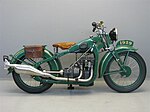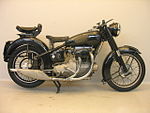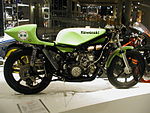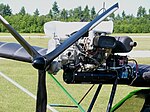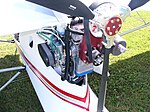| Revision as of 12:22, 3 July 2012 editTrappist the monk (talk | contribs)Administrators479,914 editsm Copyedit;← Previous edit | Revision as of 01:50, 4 July 2012 edit undoDennis Bratland (talk | contribs)Extended confirmed users61,245 edits consensus did not support split of Straight-two engine. See Talk:Straight-two engineNext edit → | ||
| Line 1: | Line 1: | ||
| {{db-meta | |||
| |bot= | |||
| |raw= | |||
| |criterion=A10 | |||
| |1= as a recently created article with no relevant page history that does not expand upon, detail, or improve information within the existing article(s) on the subject{{#if:Straight-two engine|, ] ()|{{error| (Article to which this page is redundant has not been specified)}}}} | |||
| |2=Note that splits of large articles are <b><u>not</u></b> eligible under this criterion. If the title of the page is a plausible ] to an existing page, consider redirecting instead | |||
| |temp=db-a10-notice | |||
| |temp2=<nowiki>|article=</nowiki>Straight-two engine | |||
| |notes= | |||
| |summary=Recently created article that duplicates an existing topic{{#if:Straight-two engine|, ]|}} | |||
| }}{{cat handler | |||
| | all = ]] | |||
| | nocat = | |||
| | category2 = ¬ | |||
| | page = Foo <!--CIRCUMVENT BLACKLIST--> | |||
| }} | |||
| ] | ] | ||
| An '''Inline-twin''', '''inline twin-cylinder''', or '''in-line vertical-twin'''<ref name="classic">487 cc Sunbeam. Walneck's Classic Cycle Trader, Dominion Enterprises, Dec 1996 reprinted from Classic Bike Magazine, 5 January 1950.</ref> is an internal combustion engine in which the axis of the crankshaft is inline with axis of the final drive or chassis of the vehicle.<ref>Automobile engineer: a technical journal devoted to the theory and practice of automobile and aircraft construction, Volume 43, Issue 569. Institution of Automobile Engineers. IPC Transport Press Ltd., 1953</ref> It is also known as "'''in-line'''" and '''tandem twin'''. An inline-twin engine differs from the two cylinder engine design known as a ] which has its crankshaft at a transverse or ] to final drive and the chassis of the vehicle.<ref name="Abdo">Modern Motorcycle Technology. Edward Abdo. Cengage Learning, 3 Jan 2012</ref> An inline-twin, having its crankshaft parallel to the direction of the chassis or drive, is described as being longitudinal, hence the differentiation between transverse and longitudinal parallel twins.<ref name="Abdo" /> | An '''Inline-twin''', '''inline twin-cylinder''', or '''in-line vertical-twin'''<ref name="classic">487 cc Sunbeam. Walneck's Classic Cycle Trader, Dominion Enterprises, Dec 1996 reprinted from Classic Bike Magazine, 5 January 1950.</ref> is an internal combustion engine in which the axis of the crankshaft is inline with axis of the final drive or chassis of the vehicle.<ref>Automobile engineer: a technical journal devoted to the theory and practice of automobile and aircraft construction, Volume 43, Issue 569. Institution of Automobile Engineers. IPC Transport Press Ltd., 1953</ref> It is also known as "'''in-line'''" and '''tandem twin'''. An inline-twin engine differs from the two cylinder engine design known as a ] which has its crankshaft at a transverse or ] to final drive and the chassis of the vehicle.<ref name="Abdo">Modern Motorcycle Technology. Edward Abdo. Cengage Learning, 3 Jan 2012</ref> An inline-twin, having its crankshaft parallel to the direction of the chassis or drive, is described as being longitudinal, hence the differentiation between transverse and longitudinal parallel twins.<ref name="Abdo" /> | ||
Revision as of 01:50, 4 July 2012
| This user page may meet Misplaced Pages's criteria for speedy deletion as a recently created article with no relevant page history that does not expand upon, detail, or improve information within the existing article(s) on the subject, Straight-two engine (compare pages). Note that splits of large articles are not eligible under this criterion. If the title of the page is a plausible redirect to an existing page, consider redirecting instead. See CSD A10.%5B%5BWP%3ACSD%23A10%7CA10%5D%5D%3A+Recently+created+article+that+duplicates+an+existing+topic%2C+%5B%5B%3AStraight-two+engine%5D%5DA10
If this user page does not meet the criteria for speedy deletion, or you intend to fix it, please remove this notice, but do not remove this notice from pages that you have created yourself. If you created this page and you disagree with the given reason for deletion, you can click the button below and leave a message explaining why you believe it should not be deleted. You can also visit the talk page to check if you have received a response to your message. Note that this user page may be deleted at any time if it unquestionably meets the speedy deletion criteria, or if an explanation posted to the talk page is found to be insufficient.
Note to administrators: this page has content on its talk page which should be checked before deletion. Administrators: check links, talk, history (last), and logs before deletion. Consider checking Google.This page was last edited by Dennis Bratland (contribs | logs) at 01:50, 4 July 2012 (UTC) (12 years ago) |

An Inline-twin, inline twin-cylinder, or in-line vertical-twin is an internal combustion engine in which the axis of the crankshaft is inline with axis of the final drive or chassis of the vehicle. It is also known as "in-line" and tandem twin. An inline-twin engine differs from the two cylinder engine design known as a parallel-twin engine which has its crankshaft at a transverse or right angle to final drive and the chassis of the vehicle. An inline-twin, having its crankshaft parallel to the direction of the chassis or drive, is described as being longitudinal, hence the differentiation between transverse and longitudinal parallel twins.
Applications
Such engines have commonly been used in snowmobile, ultralight aircraft, tractor, ATV, Superkart, motorcycle, marine, large scale flying model aircraft and automotive applications including passenger, transportation and sports uses.
The design has been used for two-stroke, four-stroke, and diesel engines, air-cooled and water-cooled, and aspirated by both carburettors and turbochargers.
Advantages and disadvantages
Inline twins have the advantage of being compact, relatively simple, and cheap to make in comparison to V or flat twins. As with any twin cylinder engine, they have an imbalanced firing action which causes vibration and inline-twins also suffer further from torsional torque reactions and vibration.
Tandem twin engine
Not to be confused with Twin-engine.| This section needs expansion. You can help by adding to it. (July 2012) |
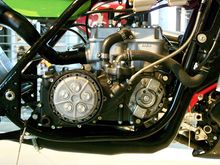
In inline tandem twins, the motor has two crankshafts, one for each cylinder and have been used in motorcycle and go-kart racing.
Automobile
Inline-twins were used in the early days of motoring in models such as the 1898 Decauville Voiturelle which used a pair of cylinders taken from a de Dion model mounted fore and aft and positioned below the seat.
In 1955, engineer Aurelio Lampredi designed an experimental inline twin cylindered F1 engine on the theory that it would provide high levels of torque for tight race circuits. The result was the 2.5-liter Type 116 prototype. Unfortunately, it vibrated so badly it broke the testbench and never made it into production.
Marine
Inline twins are common in marine use both inboard and outboard, such as the Suzuki 15 models, and as jet pump motors.
Motorcycling
In motorcycling, the term "inline engine" is used more narrowly, for a straight engine mounted in line with the frame. The inline-twin engine design has been used often during the history of motorcycling for both two-stroke and four-stroke engines. Examples include, the Dresch 500 cc Monobloc, the Sunbeam S7 and S8, Kork Ballington's world championship winning Kawasaki KR 250 and 350s and Aprilia's 1985 GP racing bikes, and the CCM Armstrong 250cc, Waddon, EMC, Hejira, Decorite, Cotton racers which all used the Rotax model 256 inline twin engine. The Kawasaki KR models won 8 world championships.
Inline-twin engines have both advantages and disadvantages for motorcycle design. Although it is a narrow twin engine design that allows for a narrow motorcycle, as narrow as a single cylinder engine, they also create a longer engine. A significant disadvantage for air-cooled engines is that the rear cylinder runs hotter than the front cylinder.
Aviation
Inline-twin engines, such as the Hirth 2704 are commonly used in Ultralight, single seat gyrocopters and small homebuilt aircraft. Another popular inline-twin two-stroke engine was the Cuyuna 430-D, a modified snowmobile unit which produced 30 hp More modern Ultralights tend to use engines such as the Rotax 503.
See also
References
- ^ 487 cc Sunbeam. Walneck's Classic Cycle Trader, Dominion Enterprises, Dec 1996 reprinted from Classic Bike Magazine, 5 January 1950.
- Automobile engineer: a technical journal devoted to the theory and practice of automobile and aircraft construction, Volume 43, Issue 569. Institution of Automobile Engineers. IPC Transport Press Ltd., 1953
- ^ Modern Motorcycle Technology. Edward Abdo. Cengage Learning, 3 Jan 2012
- Popular Mechanics, Oct 1968
- Popular Science - May 1984 - Page 105
- Snowmobile Service Manual Intertec Publishing - 1986 - 488 pages "Engines consist of two types; the axial fan, inline twin and the simultaneous firing opposed twin.
- Popular Science May 1984
- Berger-Burr's ultralight and microlight aircraft of the world, Volume 16. P.185. Alain-Yves Berger, Norman Burr. Haynes Publishing Group, 1 Jan 1983
- The Art of the John Deere Tractor: Featuring Tractors from the Walter and Bruce Keller Collection. Lee Klancher. Voyageur Press, 13 May 2011
- Rave Motorsport's Armstrong Superkart Engine
- ^ Italian Racing Motorcycles. Mick Walker. Redline Books, 1 Jan 2000
- Field & Stream, Dec 1971
- 3W-150iR2 Inline Twin, Specifications Sheet
- Classic Cars: 50 Years of the World's Finest Automotive Design. Brazendale - 1983 - 368 pages "They were vee-twin-cylinder engines designed by Daimler, which were replaced by the inline, twin-cylinder unit as used in the Phoenix of 1895."
- "They can't all be GTOs." Motor Trend Oct. 2007: 118. General OneFile. Web. 29 June 2012. "Not everything Ferrari touches turns to blazing scarlet. In 1955, for instance, engineer Aurelio Lampredi—working with Enzo and son Dino—creates an experimental inline-two-cylinder F1 engine (the theory being that two large cylinders would provide enormous torque for tight circuits like Monaco)."
- Tata Motors Limited Files Patent Application for a Novel Inline Two Cylinder Multi Point Fuel Injection Four-Stroke Reciprocating Piston Internal Combustion Naturally Aspirated or Turbocharged or Turbocharged Intercooled Spark Ignition Engine.
- "Emission-compliant diesel engines cover 83 to 1,350 bhp in 10 models." Oil, Gas, & Petrochem Equipment May 2006: 18. General OneFile. Web. 29 June 2012. "Cat petroleum diesels line includes eight inline two, three, and four-cylinder engines
- PSA fires up two-cylinder turbo. Automotive Engineer, Oct 2008
- The Internal-combustion Engine in Theory and Practice: Combustion, fuels, materials, design. Charles Fayette Taylor. MIT Press, 19 Mar 1985
- ^ Light and Heavy Vehicle Technology. M J J Nunney. Routledge, 31 May 2012
- Cycle World, Volume 46. CBS Publications, 2007
- BRC250FE Tech Data Sept 05
- Transactions of the International Engineering Congress, 1916
- Cycle World, Volume 23. CBS Publications, 1984
- Antique cars Michael Sedgwick, 1980 - 93 pages "The engine, an inline twin, lived in a box like a meat-safe at the rear."
- The Secret History of Ferrari: Sixty years of cars, stars, and stories you've never heard, Arthur St. Antoine, Matt Stone. Motor Trend, October 1, 2007
- Popular Mechanics - Feb 1989 - Page 109. Vol. 166, No. 2 - 136 pages - Magazine "Also new from Suzuki are the inline twin 15 and the inline 3-cylinder 25. Both are equipped with loop-charging, oil injection and external-mount tilt and trim. The 25 also has pre-atomized oil injection and an overrev limiter."
- 2 Stroke International Marine Engines & Jet Pumps
- Wilson, Hugo (1995). "Glossary" (in UK English). The Encyclopedia of the Motorcycle. London: Dorling Kindersley. pp. 309 – 310. ISBN 0-7513-0206-6. "in-line Engine layout in which the cylinders are arranged in a row, and in-line with the wheels of the machine."
- Watanabe, Laurie. "That magnificent man on his riding machines." Dealernews Nov. 1996: 26+. General OneFile. Web. 29 June 2012. "If you press him, though, Jim is likely to expound on his 1947 S7 Sunbeam - "twin-cylinder, rubber-mounted engine. They were an inline two-cylinder, not crosswise in the frame, like conventional twins are.""
- Japanese Production Racing Motorcycles - Page 130. Mick Walker - 2004 - 336 pages "... the KR750 and its KR250/350 inline twin cylinder Grand Prix racers."
- Mick Walker's European Racing Motorcycles. Mick Walker. Redline Books, 1 Mar 2000
- Motorcycle Design and Technology Handbook. Gaetano Cocco. MotorBooks International, 1 Aug 2004
- Ultimate History of Fast Bikes. Roland Brown. Parragon, 1 Sep 2003
- Cliche, Andre: Ultralight Aircraft Shopper's Guide 8th Edition, pages G-3 and G-4 Cybair Limited Publishing, 2001. ISBN 0-9680628-1-4
- Machine Design: Volume 54, Issues 1-6; Volume 54, Issues 1-6 1982 "A modified snowmobile power plant, the 30-hp inline twin has been detuned by lowering the compression ratio and modifying the carburetion"
- Ultralight aircraft Michael A. Markowski - 1982 - 320 pages - "The Cuyuna 430-D is an inline twin cylinder of 30 hp."
- Operators Manual for Engine Types 447, 503, 582
| Engine configurations for piston engines | |||||||||||
|---|---|---|---|---|---|---|---|---|---|---|---|
| Type | |||||||||||
| Stroke cycles | |||||||||||
| Cylinder layouts |
| ||||||||||



